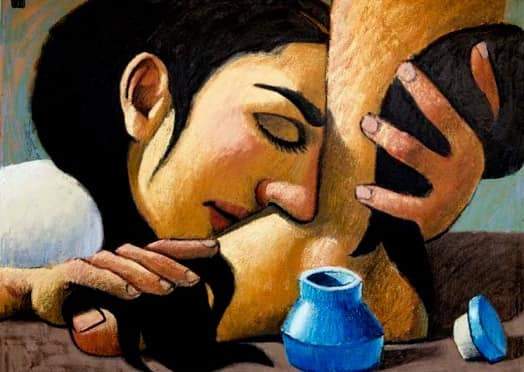Homily for 17 September 2020, Thursday of the 24th Week in Ordinary Time, Memorial of St. Robert Bellarmine, Luke 7:36-50
Today’s Gospel is about the MESSIAH, having a MASSAGE.
I wonder if you know that these two words, MESSIAH and MASSAGE come from the same root word in Hebrew: MASHAH, MASHIAH, which has to do with anointing.
Massage has always been recognized as a legitimate form of physical theraphy. And since the theraphy involved a lot of physical contact, in many instances in history, it tended to develop a bad meaning. Even in our country there were times when massage parlors got associated with places of prostitution. Today’s Gospel is one evidence that this tendency for massage attendants to develop a bad reputation was there already during the time of Jesus.
Incidentally, let me remind you that the massage attendant who is labeled in the Gospel as a “sinful woman” or a “woman of ill repute” or simply a prostitute, has nothing to do with Mary Magdalene. The story just happens to be followed by a reference to the women disciples who are introduced by Luke in the beginning of the chapter that follows. Among them, Mary Magdalene is identified as “the woman from whom seven demons had gone out”. (Luk 8:2)
Back to the dinner scene. Luke tells us that while dinner was going on in the house of Simon the Pharisee, a massage attendant had come in, probably to offer her services to the guests. But she went straight to the Rabbi from Nazareth who happened to be the guest of honor, whom the host regarded as a prophet or a holy man.
The massage attendant was aware of the sign whether or not a prospective client wanted her services, even without an explicit transaction. By the way, it was the Romans who introduced to the Jews the culture of reclining instead of sitting at table especially for festive occasions like banquets. They invented a different kind of table on which the guests could recline comfortably. In Latin they called it a TRICLINIUM, a structure shaped like a U, with the heads of the guests facing the edge which was an open space in the U where the food was served. Their feet were usually dangling on the other end, the lower end, where massage attendants could perform their services.
Like I said, even without transaction, the attendant would know if a prospective client wanted her services or not. All that the prospective client had to do was to withdraw or pull his foot away. It was enough to say through body language, “No, thank you.” If she persisted, and the client got annoyed, she could get kicked by him.
I suspect that the Pharisees had allowed this woman to enter the banquet scene and offer her services on purpose, in order precisely to test Jesus. Would he or would he not welcome the services of a massage attendant? Well, to their dismay, not only did Jesus allow her to touch him, he seemed to even enjoy the expensive foot spa; and the way the woman did it seemed every bit erotic and seductive in the eyes of the host. Listen to the description, “She bathed his feet, wiped them with her hair, kissed them, and anointed them.”
What did the host see? He saw something scandalous—a supposedly holy man allowing himself to be massaged publicly by a woman he regarded as a prostitute.
What did Jesus see? He saw the tears of a woman who had repented of her sins and was expressing sincere gratitude for being forgiven. I suspect that this was not a first encounter because Jesus says, “She has shown great love because her many sins have been forgiven.”
You see, even when people are looking at the same thing, they do not always see the same thing. We do not realize that our perceptions are often colored or conditioned by our presuppositions, our biases, prejudices and bigoted attitudes. The Pharisee saw something scandalous; Jesus saw a sincere gesture of love, repentance and gratitude for God’s mercy.
They say it is often the big sinners who turn into big time saints when they repent. It is what Jesus tries to point out to the Pharisee who is reacting, not to the reality before him but to his perception of it. “The one to whom much is forgiven loves much, while the one to whom whom little is forgiven loves little.”
This sounds more appropriate in Tagalog because we use the term PAGPUPUNO SA PAGKUKULANG (filling up an inadequacy) as an image of forgiveness. The bigger the shortcoming, the more grace is needed to fill it up with. This also radically changes the perspectives: because God looks with the eyes of mercy, what he sees in a sinner is a potential saint. We often project on God what we see with eyes blinded by self-righteousness.
There is a saying that expresses well the opposite of seeing through the lenses of self-righteousness, and it is quoted by a very controversial English writer, Oscar Wilde. I think it is the best way of describing the uniqueness of Jesus’ perspective of mercy: “Every saint has a past; every sinner has a future.”











